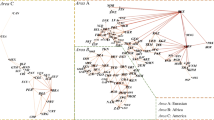Abstract
The availability of massive network and mobility data from diverse domains has fostered the analysis of human behavior and interactions. Broad, extensive, and multidisciplinary research has been devoted to the extraction of non-trivial knowledge from this novel form of data. We propose a general method to determine the influence of social and mobility behavior over a specific geographical area in order to evaluate to what extent the current administrative borders represent the real basin of human movement. We build a network representation of human movement starting with vehicle GPS tracks and extract relevant clusters, which are then mapped back onto the territory, finding a good match with the existing administrative borders. The novelty of our approach is the focus on a detailed spatial resolution, we map emerging borders in terms of individual municipalities, rather than macro regional or national areas. We present a series of experiments to illustrate and evaluate the effectiveness of our approach.


Similar content being viewed by others
References
Aiello W, Chung F, Lu L (2000) A random graph model for massive graphs. In: STOC. ACM, New York, pp 171–180
Ankerst M, Breunig MM, Kriegel HP, Sander J (1999) Optics: Ordering points to identify the clustering structure. In: SIGMOD, pp 49–60
Benevenuto F, Rodrigues T, Cha M, Almeida VAF (2009) Characterizing user behavior in online social networks. In: Internet measurement conference, pp 49–62
Bringmann B, Berlingerio M, Bonchi F, Gionis A (2010) Learning and predicting the evolution of social networks. IEEE Intell Syst 25:26–35
De Castro R, Grossman JW (1999) Famous trails to Paul Erdös. Math Intell 21:51–63
Clauset A, Newman MEJ, Moore C (2004) Finding community structure in very large networks. Phys Rev E, Stat Nonlinear Soft Matter Phys 70:066111
Cook DJ, Crandall AS, Singla G, Thomas B (2010) Detection of social interaction in smart spaces. Cybern Syst 41(2):90–104
Coscia M, Giannotti F, Pedreschi D (2011) A classification for community discovery methods in complex networks. Stat Anal Data Min 4(5):512–546
Ester M, Kriegel H-P, Sander J, Xu X (1996) A density-based algorithm for discovering clusters in large spatial databases with noise. In: SIGKDD. AAAI Press, Menlo Park, pp 226–231
Fortunato S (2010) Community detection in graphs. Phys Rep 486:75–174
Fortunato S, Barthélemy M (2007) Resolution limit in community detection. Proc Natl Acad Sci USA 104(1):36–41
Giannotti F, Nanni M, Pinelli F, Pedreschi D (2007) Trajectory pattern mining. In: SIGKDD, pp 330–339
Gomez-Rodriguez M, Leskovec J, Krause A (2010) Inferring networks of diffusion and influence. In: SIGKDD, pp 1019–1028
Guimera R, Nunes Amaral KA (2005) Functional cartography of complex metabolic networks. Nature 433(7028):895–900
Hecker D, Körner C, Stange H, Schulz D, May M (2011) Modeling micro-movement variability in mobility studies. In: Advancing geoinformation science for a changing world, LNG&C, vol 1, pp 121–140
Kaufman L, Rousseeuw PJ (1990) Finding groups in data: an introduction to cluster analysis. Wiley, New York
Lancichinetti A, Fortunato S (2009) Community detection algorithms: a comparative analysis. Phys Rev E, Stat Nonlinear Soft Matter Phys 80:5
Monreale A, Pinelli F, Trasarti R, Giannotti F (2009) Wherenext: a location predictor on trajectory pattern mining. In: KDD, pp 637–646
Nowell DL, Kleinberg J (2003) The link prediction problem for social networks. In: CIKM, pp 556–559
Page L, Brin S, Motwani R, Winograd T (1998) The pagerank citation ranking: bringing order to the web
Ratti C, Sobolevsky S, Calabrese F, Andris C, Reades J, Martino M, Claxton R, Strogatz SH (2010) Redrawing the map of great Britain from a network of human interactions. PLoS ONE 5(12):5:e14248
Rosvall M, Bergstrom CT (2008) Maps of random walks on complex networks reveal community structure. Proc Natl Acad Sci USA 105:1118–1123
Thiemann C, Theis F, Grady D, Brune R, Brockmann D (2010) The structure of borders in a small world. PLoS ONE 5:11
Wang D, Pedreschi D, Song C, Giannotti F, Barabasi AL (2011) Human mobility, social ties, and link prediction. In: SIGKDD, pp 1100–1108
Yan X, Han J (2002) gspan: Graph-based substructure pattern mining. In: ICDM.
Yan Z, Chakraborty D, Parent C, Spaccapietra S, Aberer K (2011) Semitri: a framework for semantic annotation of heterogeneous trajectories. In: EDBT/ICDT, pp 259–270
Yang J, Leskovec J (2010) Modeling information diffusion in implicit networks. In: ICDM, pp 599–608
Acknowledgements
The authors wish to thank Alessandro Grossi and Michele Berlingerio for their technical support. We also acknowledge Octo Telematics S.p.A. for providing the datasets. The research leading to these results has received funding from the European Union Seventh Framework Programme (FP7/2007-2013) under grant agreement No. 270833.
Author information
Authors and Affiliations
Corresponding author
Rights and permissions
About this article
Cite this article
Rinzivillo, S., Mainardi, S., Pezzoni, F. et al. Discovering the Geographical Borders of Human Mobility. Künstl Intell 26, 253–260 (2012). https://doi.org/10.1007/s13218-012-0181-8
Received:
Accepted:
Published:
Issue Date:
DOI: https://doi.org/10.1007/s13218-012-0181-8




